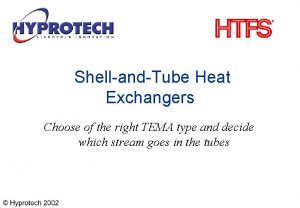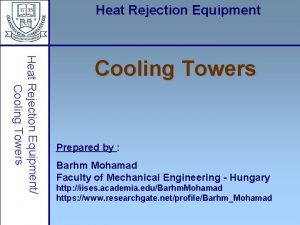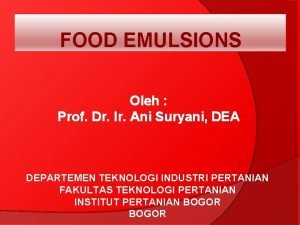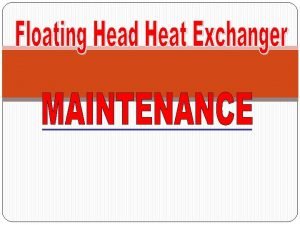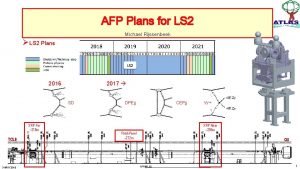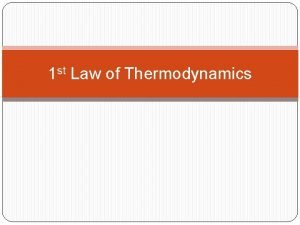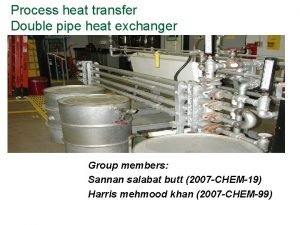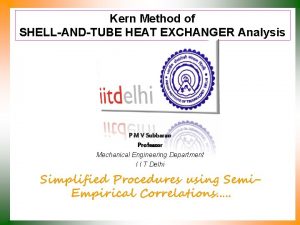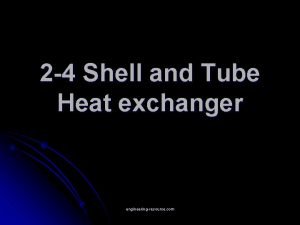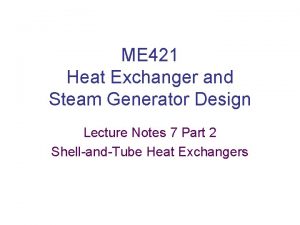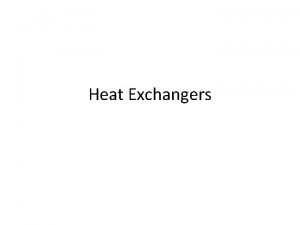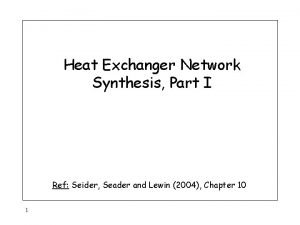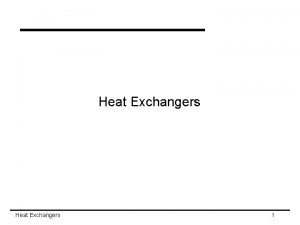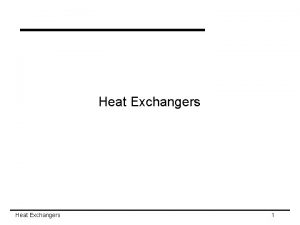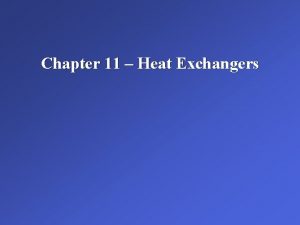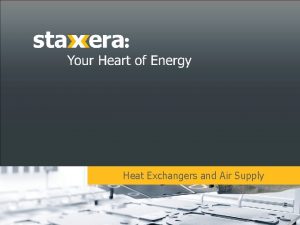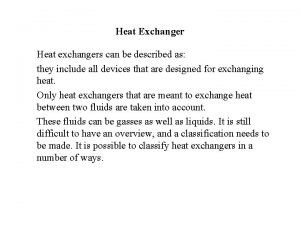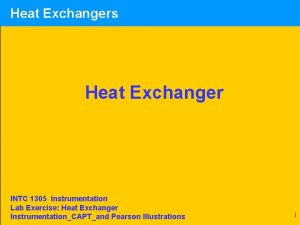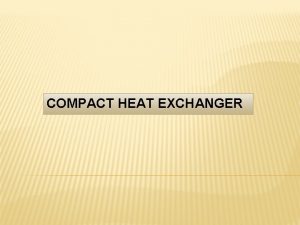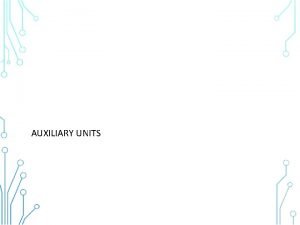Heat Exchangers Design Considerations Types Heat Exchanger Types













- Slides: 13

Heat Exchangers: Design Considerations

Types Heat Exchanger Types Heat exchangers are ubiquitous to energy conversion and utilization. They involve heat exchange between two fluids separated by a solid and encompass a wide range of flow configurations. • Concentric-Tube Heat Exchangers Parallel Flow Counterflow Ø Simplest configuration. Ø Superior performance associated with counter flow.

Types (cont. ) • Cross-flow Heat Exchangers Finned-Both Fluids Unmixed Unfinned-One Fluid Mixed the Other Unmixed Ø For cross-flow over the tubes, fluid motion, and hence mixing, in the transverse direction (y) is prevented for the finned tubes, but occurs for the unfinned condition. Ø Heat exchanger performance is influenced by mixing.

Types (cont. ) • Shell-and-Tube Heat Exchangers One Shell Pass and One Tube Pass Ø Baffles are used to establish a cross-flow and to induce turbulent mixing of the shell-side fluid, both of which enhance convection. Ø The number of tube and shell passes may be varied, e. g. : One Shell Pass, Two Tube Passes Two Shell Passes, Four Tube Passes

Types (cont. ) • Compact Heat Exchangers Ø Widely used to achieve large heat rates per unit volume, particularly when one or both fluids is a gas. Ø Characterized by large heat transfer surface areas per unit volume, small flow passages, and laminar flow. (a) (b) (c) (d) (e) Fin-tube (flat tubes, continuous plate fins) Fin-tube (circular tubes, circular fins) Plate-fin (single pass) Plate-fin (multipass)

Tubular Exchanger Manufacturers Association

Overall Coefficient Overall Heat Transfer Coefficient 1 / U A = 1 / h 1 A 1 + dxw / k A + 1 / h 2 A 2 where U = the overall heat transfer coefficient (W/m 2 K) A = the contact area for each fluid side (m 2) k = thermal conductivity of the material (W/m. K) h = the individual convection heat transfer coefficient for each fluid (W/m 2 K) dxw = the wall thickness (m)

Overall Coefficient where kw - Thermal Conductivity of Fluid DH - Hydraulic Diameter Nu - Nusselt Number where: • ν : kinematic viscosity, ν = μ / ρ, (SI units : m 2/s) • α : thermal diffusivity, α = k / (ρcp), (SI units : m 2/s) • μ : dynamic viscosity, (SI units : Pa s) • k: thermal conductivity, (SI units : W/(m K) ) • cp : specific heat, (SI units : J/(kg K) ) • ρ : density, (SI units : kg/m 3 ). • V : Fluid velocity (SI units m/s) • L : Pipe Internal Diameter (SI units m) n = 0. 4 for heating (wall hotter than the bulk fluid) and 0. 33 for cooling (wall cooler than the bulk fluid)

Thermal Conductivity Thermal conductivity Material (W/m K)* Diamond 1000 Silver 406 Copper 385 Gold 314 Brass 109 Aluminum 205 Iron 79. 5 Steel 50. 2

LMTD Method A Methodology for Heat Exchanger Design Calculations - The Log Mean Temperature Difference (LMTD) Method • A form of Newton’s Law of Cooling may be applied to heat exchangers by using a log-mean value of the temperature difference between the two fluids: Evaluation of depends on the heat exchanger type. • Counter-Flow Heat Exchanger:

LMTD Method (cont. ) • Parallel-Flow Heat Exchanger: Ø Note that Tc, o can not exceed Th, o for a PF HX, but can do so for a CF HX. Ø For equivalent values of UA and inlet temperatures, • Shell-and-Tube and Cross-Flow Heat Exchangers:

Energy Balance Overall Energy Balance • Application to the hot (h) and cold (c) fluids: • Assume negligible heat transfer between the exchanger and its surroundings and negligible potential and kinetic energy changes for each fluid. • Assuming no l/v phase change and constant specific heats,

Special Conditions Special Operating Conditions Ø Case (a): Ch>>Cc or h is a condensing vapor – Negligible or no change in Ø Case (b): Cc>>Ch or c is an evaporating liquid – Negligible or no change in Ø Case (c): Ch=Cc. –
 Ddi heat exchangers
Ddi heat exchangers Tema type
Tema type Heat rejection equipment
Heat rejection equipment Scraped surface heat exchangers in food industry
Scraped surface heat exchangers in food industry Floating tubesheet heat exchanger
Floating tubesheet heat exchanger Rce heat exchangers
Rce heat exchangers Ddi heat exchangers inc
Ddi heat exchangers inc Are heat exchangers isobaric
Are heat exchangers isobaric Cocurrent flow heat exchanger
Cocurrent flow heat exchanger Sieder tate equation
Sieder tate equation 2-4 shell tube heat exchanger
2-4 shell tube heat exchanger Steam heat exchanger design
Steam heat exchanger design Tubesheet heat exchanger
Tubesheet heat exchanger Heat exchanger network synthesis
Heat exchanger network synthesis

